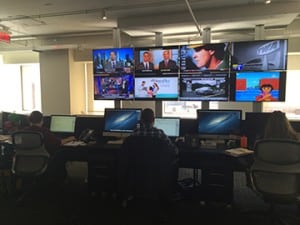Seeking to more fully integrate the digital world into its newsgathering, Fox News Channel recently rolled out a new newsroom that is stuffed with massive touchscreens and a 38-foot video wall that can be controlled with a Wii-like remote.
The home of “fair and balanced” news is hardly alone. Plenty of PR agencies have also been building newsroom-like areas in their offices to help serve their clients in new and innovative ways. Agencies are looking to use their newsrooms to not only help push out stories about their clients, but monitor all forms of media and react to the news of the day, putting forth their client’s message in real time.
The new PR newsrooms serve as engine rooms of sorts, generating ideas and energy to keep brands’ names alive on the trending charts as well as the daily zeitgeist. When NBC’s Al Roker overslept this past August and missed his first TV show in 39 years, GolinHarris tweeted on behalf ofclient McDonald’s to say, “Stick with us @AlRoker, we’ll help you wake up for the next 39 years #McCafe.” Naturally, the folks at the “Today” show read the tweet on the air that morning.
“Basically, we won the day, and we’re operating like real newsrooms do,” said Tony Telloni, managing director at GolinHarris. The agency installed its quasi newsroom, dubbed “The Bridge,” in 2011 when the company was completely reorganizing. It was part of a new set of products and services that the agency was offering its clients. In the last two years it has become a centerpiece to the agency, so much so that when visitors step off the elevators in the New York office they are greeted by a view of The Bridge.
Building The Bridge required a significant investment initially. The agency has had to invest in the newsroom’s maintenance, especially since it now has versions in several satellite offices throughout the world. The New York Bridge has five full-time staffers and is scheduled for expansion in the near future when the office moves to a larger space. The Bridge outlets in Chicago, where GolinHarris is based, and Dallas, have more full-timers.
“The Bridge doesn’t have its own line in the budget,” Telloni said. “It’s part of our overall operating budget. It is part of what we do.”
‘CREATIVE NEWSROOMS’
Cisco Systems, a GolinHarris client, was particularly pleased when The Bridge was paying close attention to the Boston Marathon.
“We had some social content tied to the event planned for the brand campaign,” said Charlie Treadwell, social and digital marketing manager at Cisco. “The Bridge spotted the bombing [at the race] before it was even on the news, and advised us to pull the content before it was published. It prevented Cisco from appearing to be a disconnected brand with no appreciation of the gravity of the situation.”
Telloni points out that most clients are excited about the prospect of working with The Bridge but not all of them are quite ready for it, mainly because of concerns from the companies’ legal departments.
Edelman has five “Creative Newsrooms” in the U.S., one in development in the States and one in Europe. Each is funded depending on how each home office uses it. “The offices have leeway in determining how they want to manage the financials, including ROI,” said Mark Hass, president and CEO, Edelman U.S. “Build-out and technology costs vary office by office. We’re very bullish about the business opportunity based on experience so far and the feedback from clients we’re introducing it to.”
Ogilvy takes a slightly different tack. Each morning the staff meets to discuss how to capitalize on the overnight news to help their clients. Ogilvy also advises clients to create their own in-house newsrooms.
“They need to bring on content creators, writers, videographers, photographers, so they can respond to the news quickly and become a go-to place for information instead of just another boring corporate website,” said Jennifer Risi, head of Ogilvy Public Relations’ Media Influence group.

NEW HIRES
Edelman’s Hass notes that copyrights guidance and licensing are two of the current areas that Edelman’s Creative Newsroom are focusing on when it comes to training. “Training is expanding quickly to accommodate the evolving needs of the newsroom,” he said.
Training also spurs existing PR staffers to think differently, as the shift to the newsroom mentality helps to build a more diverse and creative communications team. “We also continue to make new hires with backgrounds in visual, digital and traditional news and information,” Haas said.
All those new hires are just an indication of the new energy and direction PR agencies are going, as public relations becomes more and more of a real-time sport. PRN
CONTACT:
Alan Danzis, [email protected]; Mark Hass, [email protected]. Jennifer Risi, [email protected]; Tony Telloni, [email protected].
3 Tips on How to Create A ‘PR Newsroom’
 Alan Danzis, chief of Golin Harris’ Bridge program in New York, shares his thoughts on what PR agencies should aim for when building their own newsrooms.
Alan Danzis, chief of Golin Harris’ Bridge program in New York, shares his thoughts on what PR agencies should aim for when building their own newsrooms.
1. Make your newsroom the centerpiece of the office. You want to encourage all employees, whether or not they actively participate in your newsroom, to ideate and share trends.
2. Don’t just focus on social media and online news stories. They’re all critical, especially as it relates to real-time, in-the-moment opportunities. But don’t ignore traditional media as well. We monitor traditional media like broadcast media, long-lead magazines and newspapers just as much as social and online media.
3. Make it more than just a location. Make your newsroom less a physical location and more like a mindset. When we’re not physically sitting in The Bridge, we’re reading the trending stories and constantly ideating for clients. For instance, we’ll scroll Feedly or another RSS reader on our iPhones on our commute. Or we’ll pull up the BuzzFeed app during lunch to check what’s new. Or we’ll scroll Twitter while watching TV at night. We’re always on and we’re always thinking. In addition, we’ve taken The Bridge mobile for clients like Fruttare (Unilever) and Cisco to help do real-time monitoring and activating at consumers and trade events.
The look of Golin Harris’ “Bridge” is an indication of how many PR departments and agencies are starting to resemble actual newsrooms.
This article appeared in the October 21 issue of PR News. Subscribe to PR News today to receive weekly comprehensive coverage of the most fundamental PR topics from visual storytelling to crisis management to media training.
